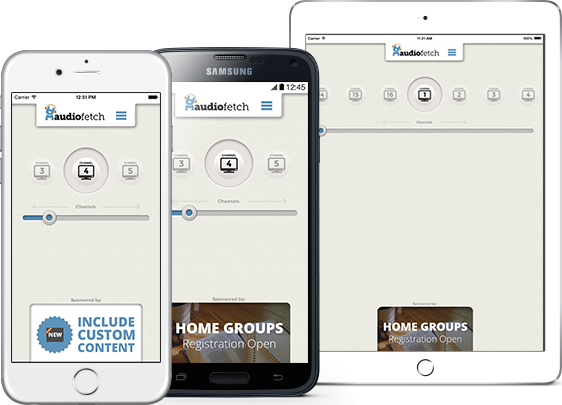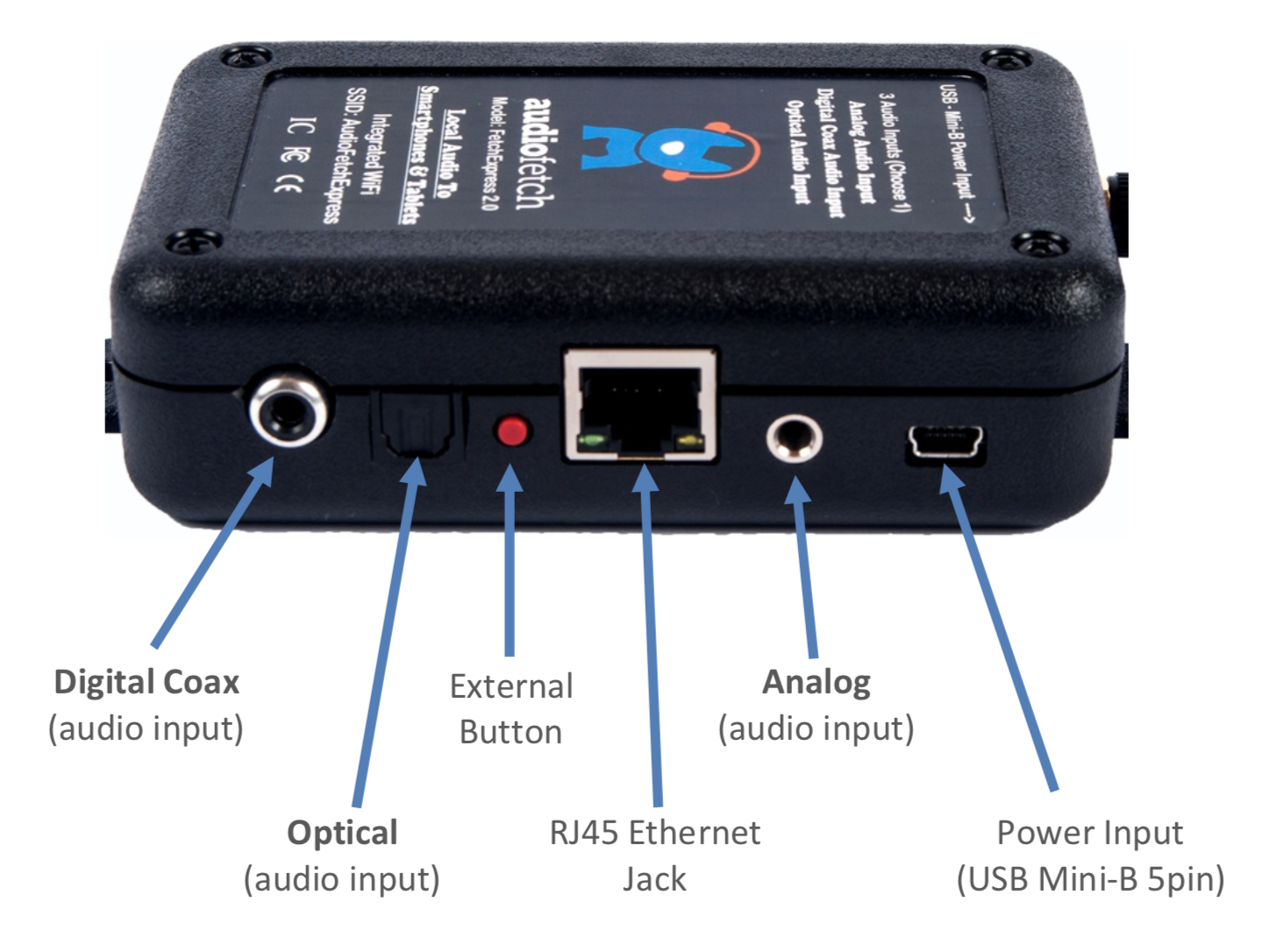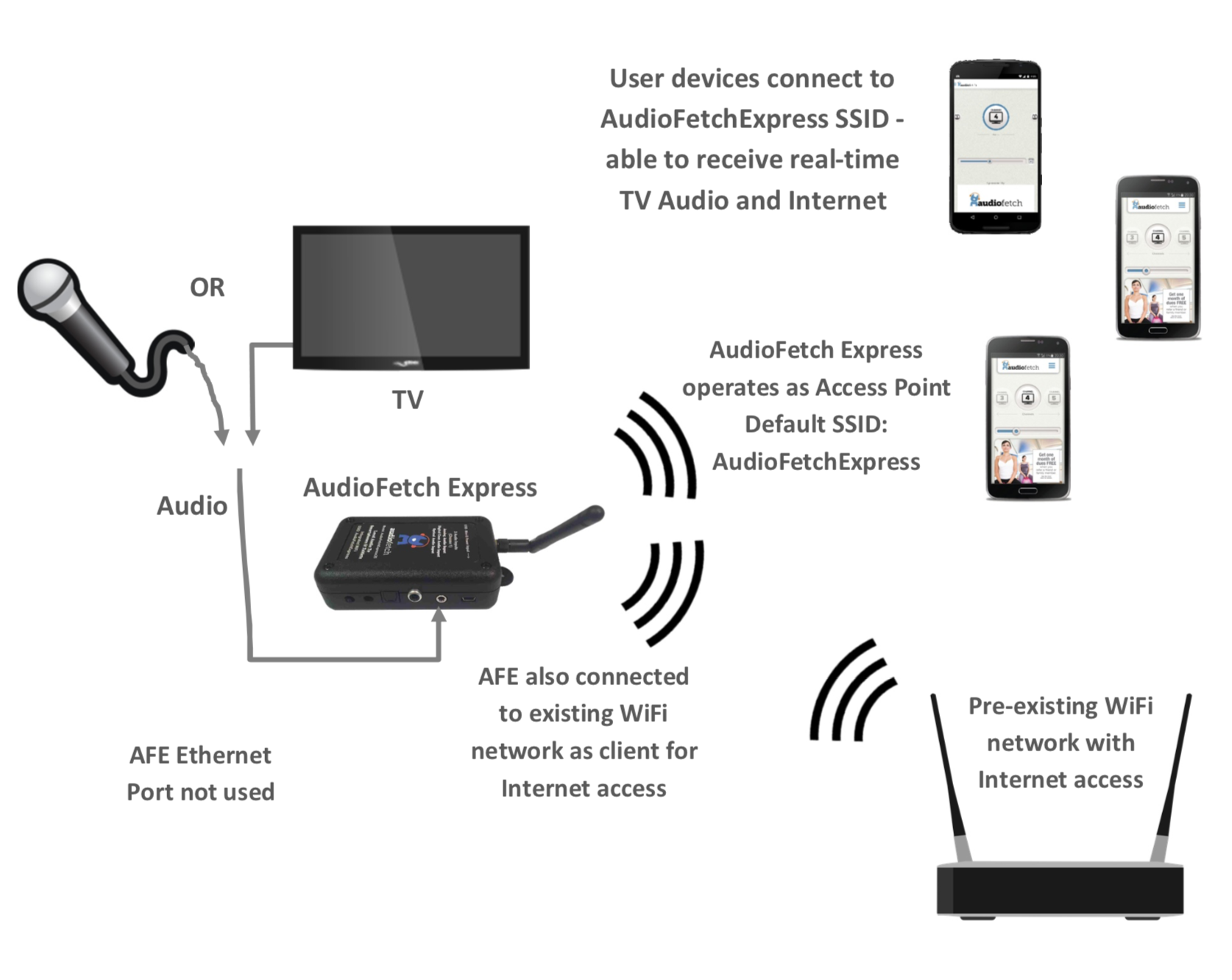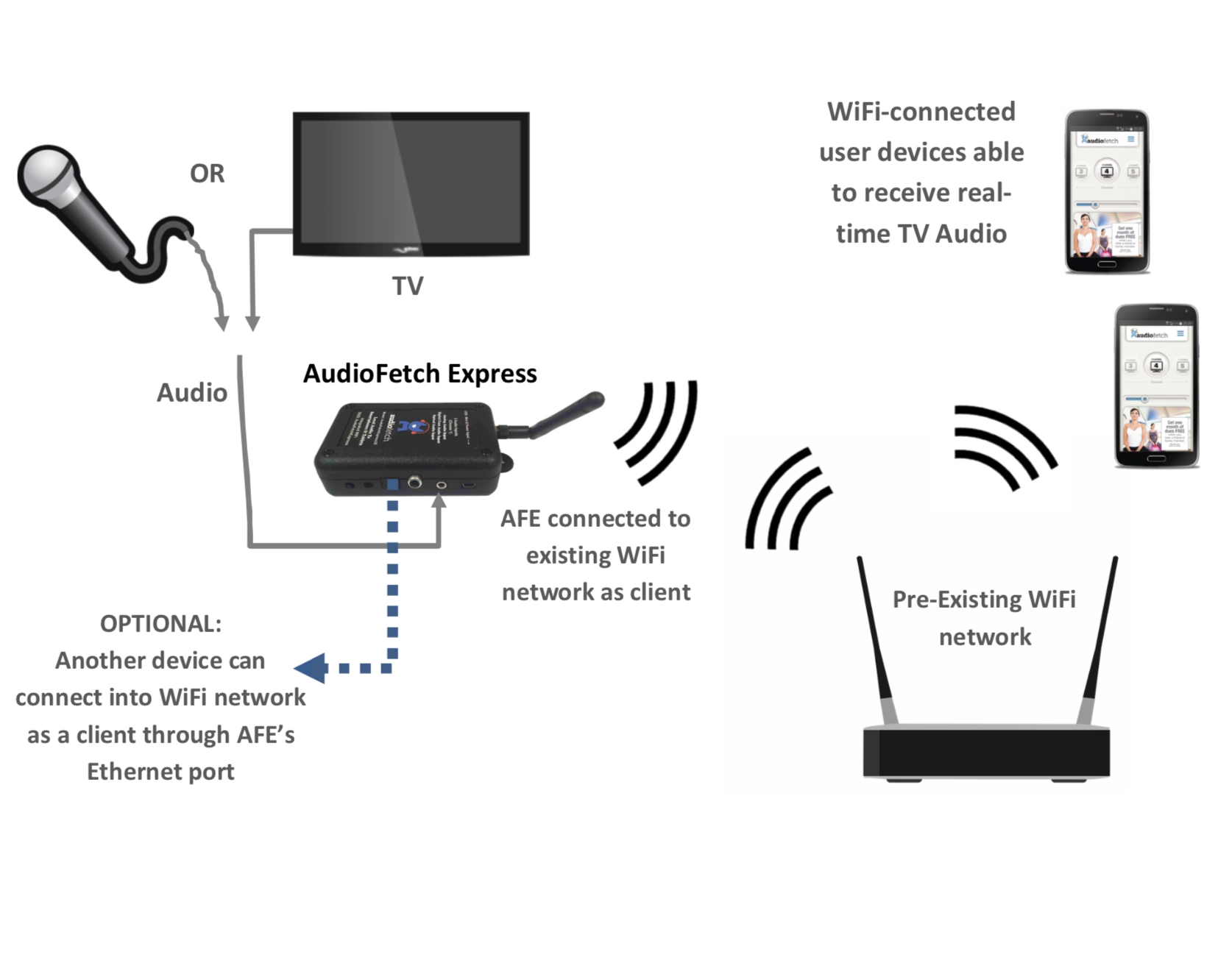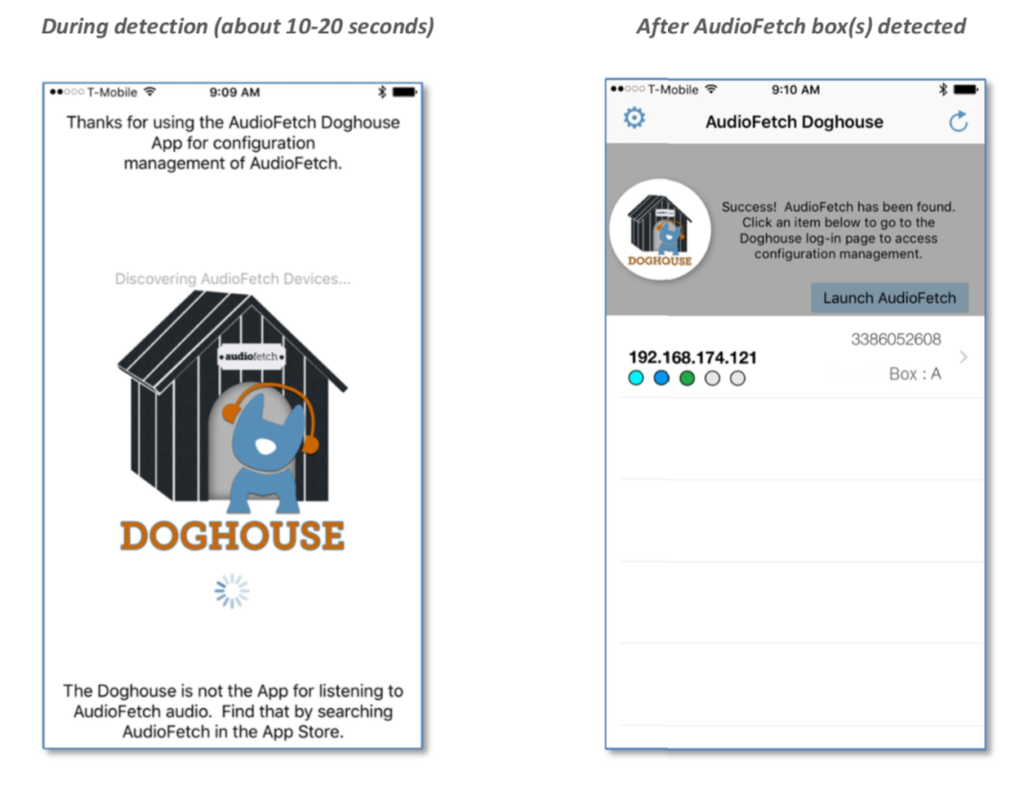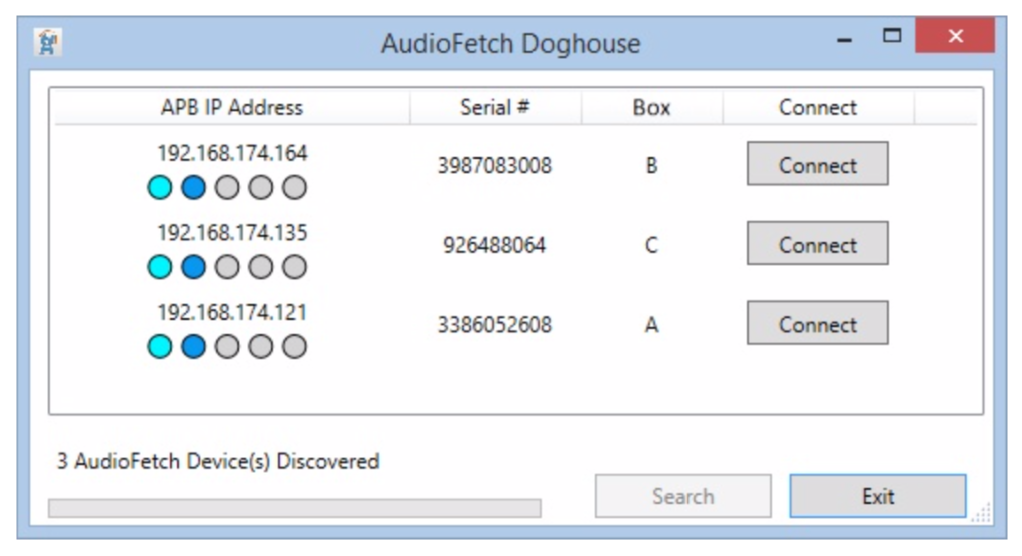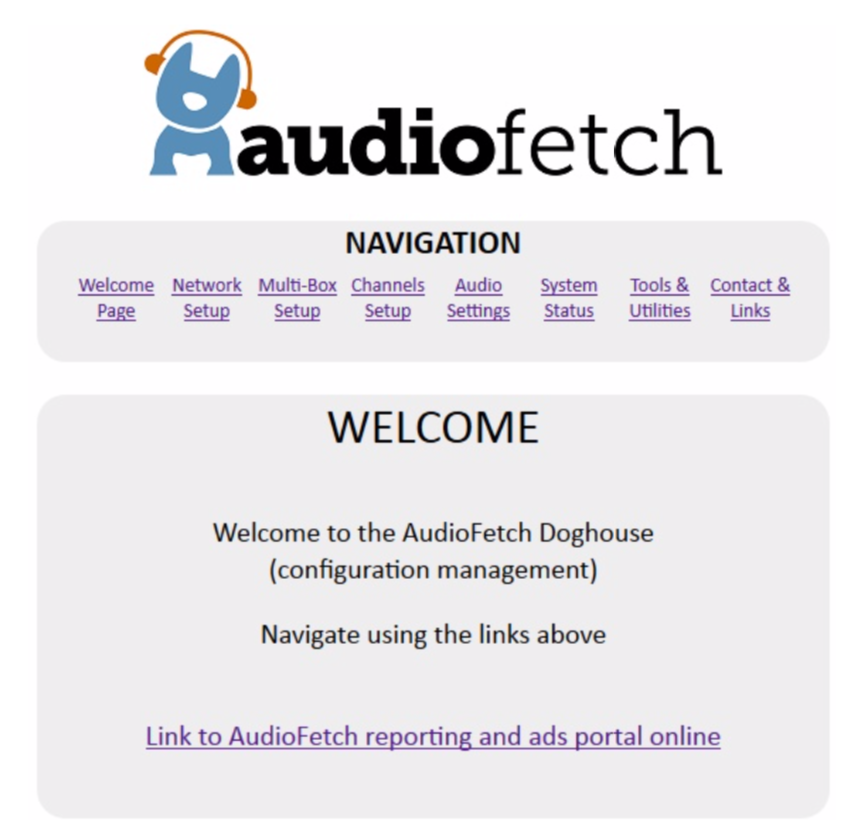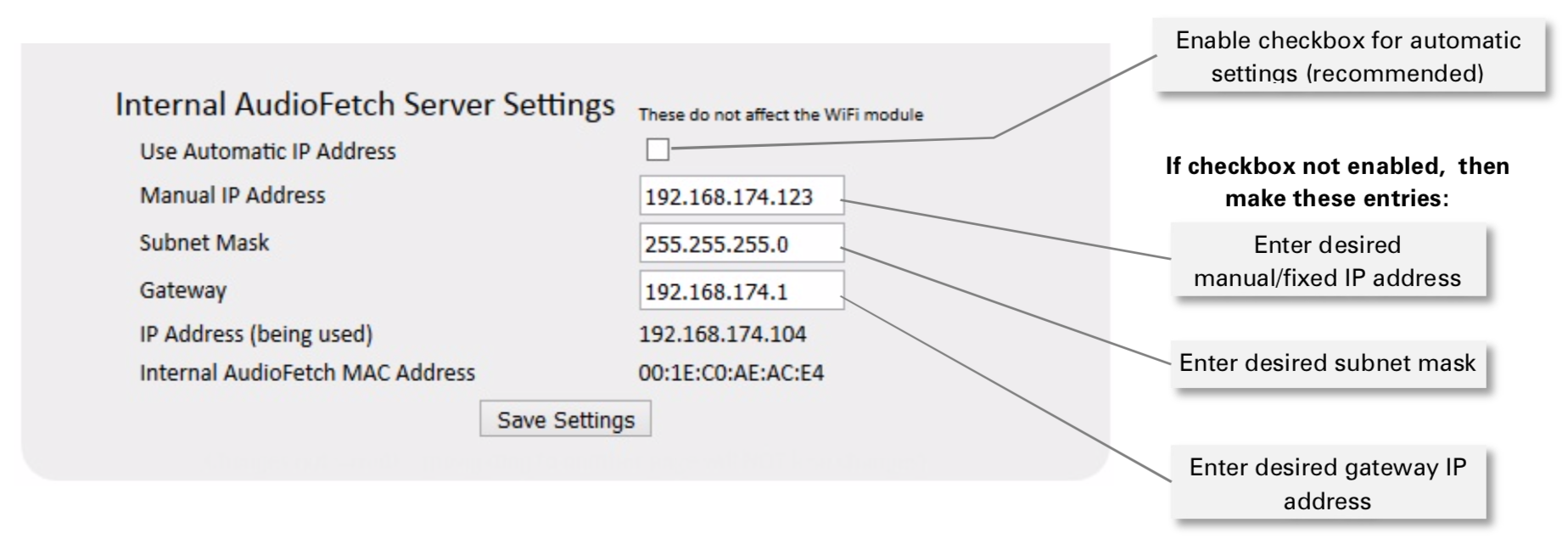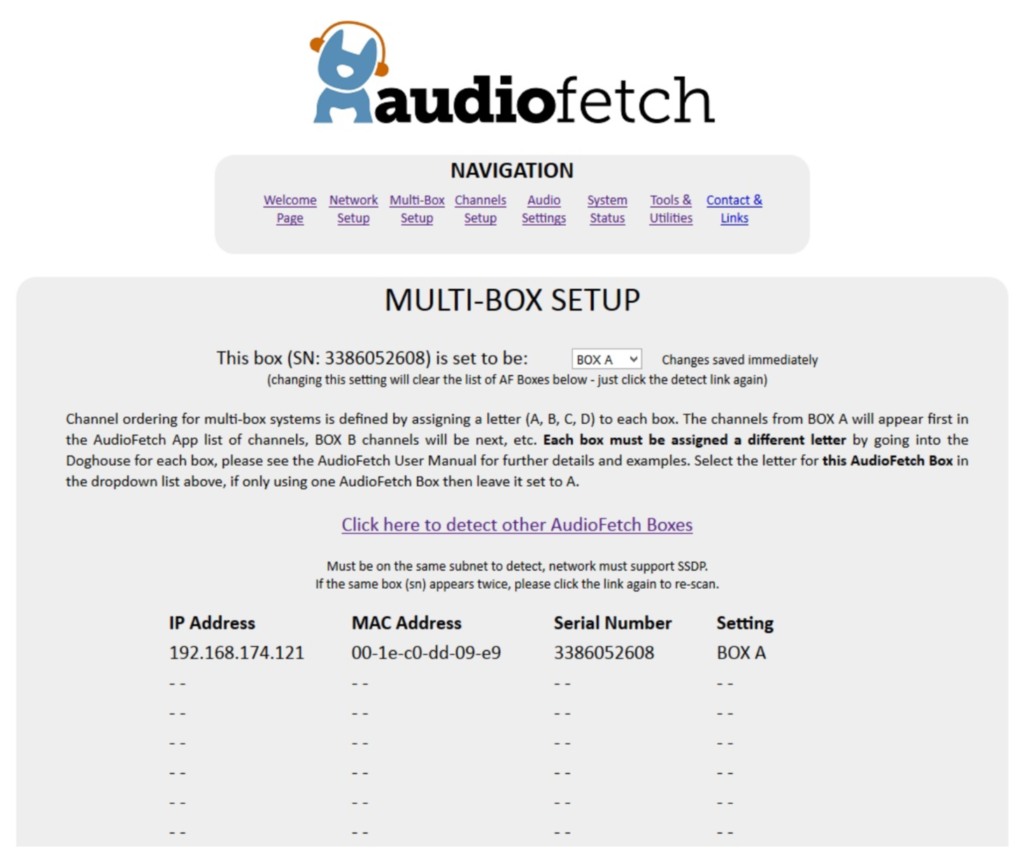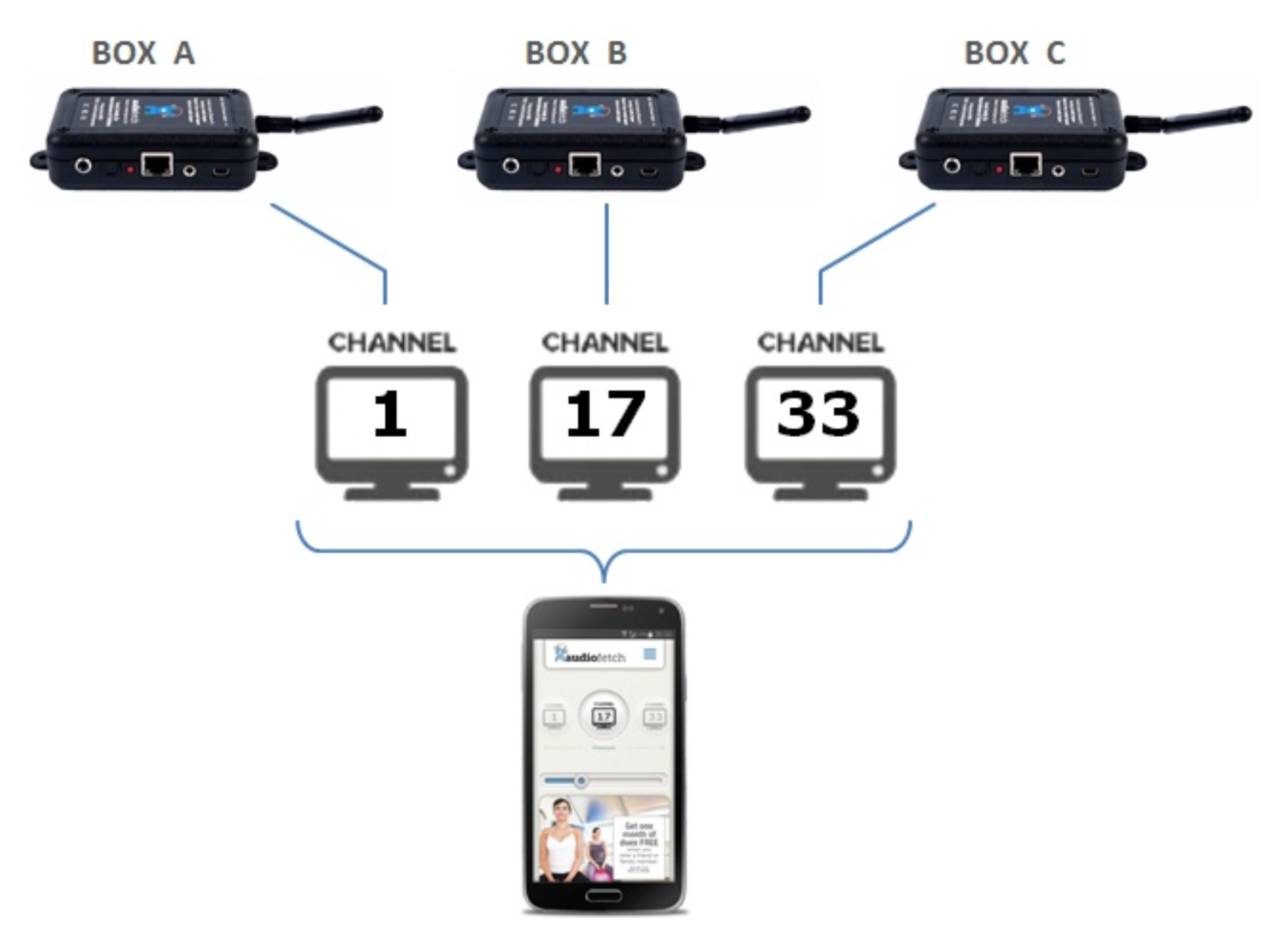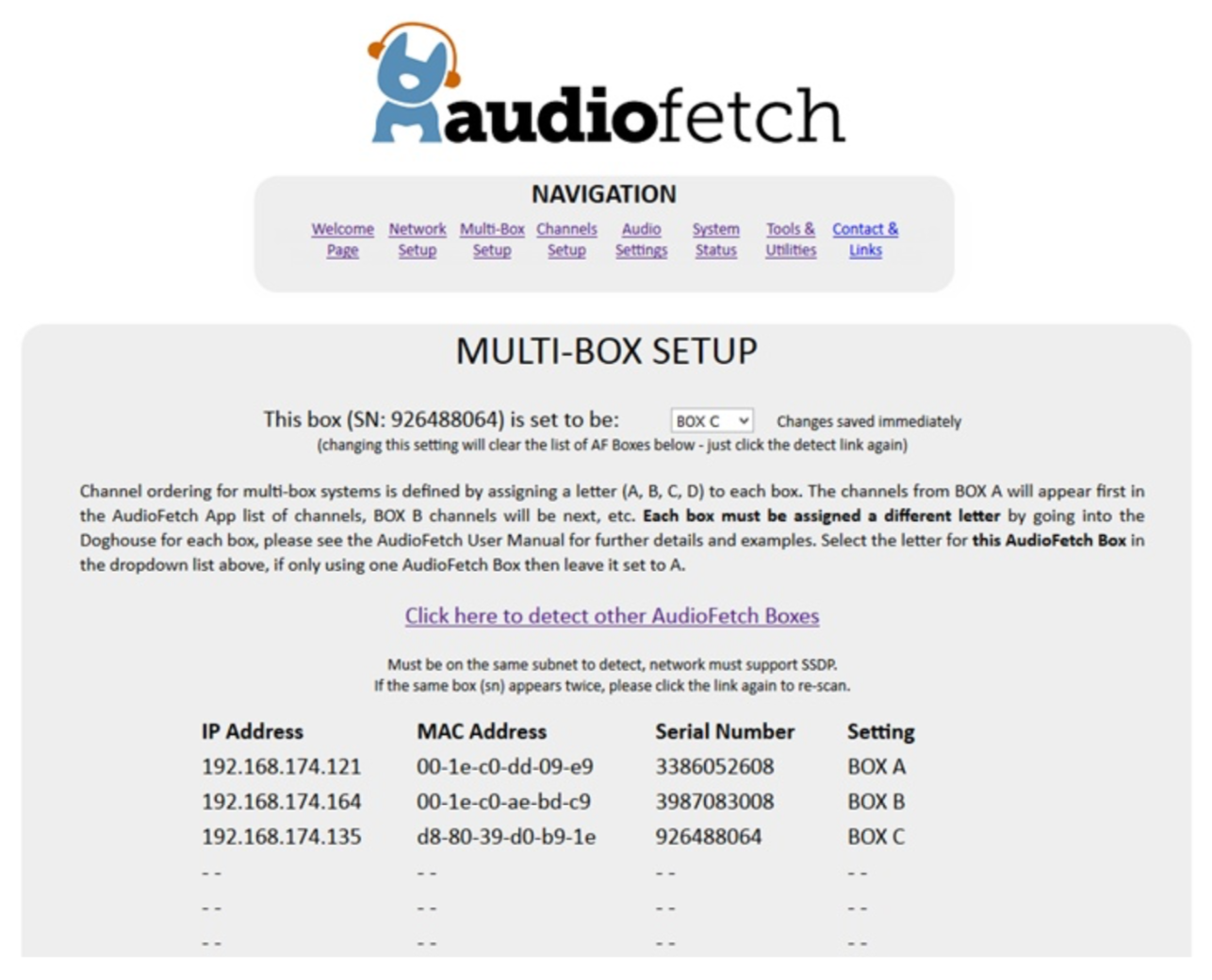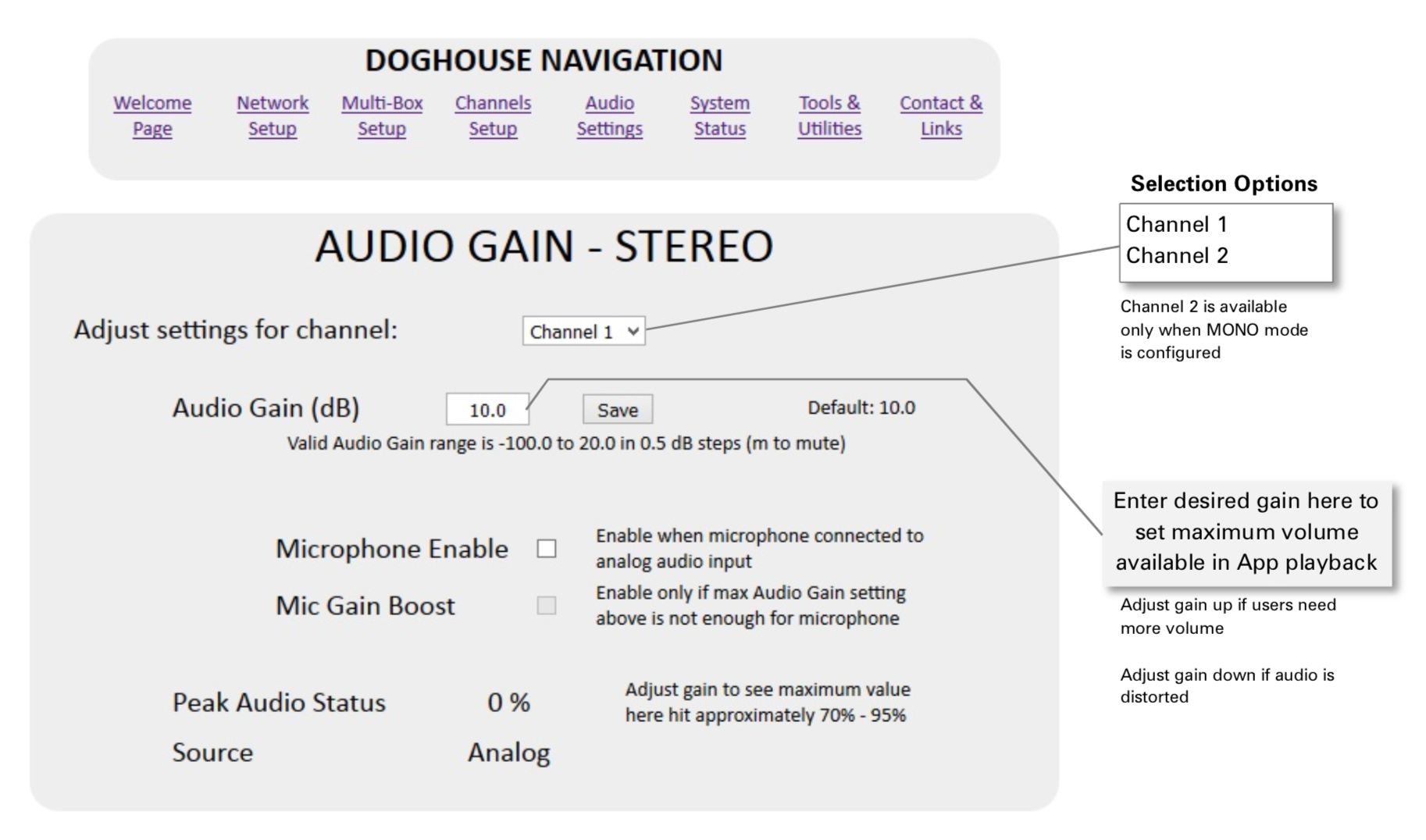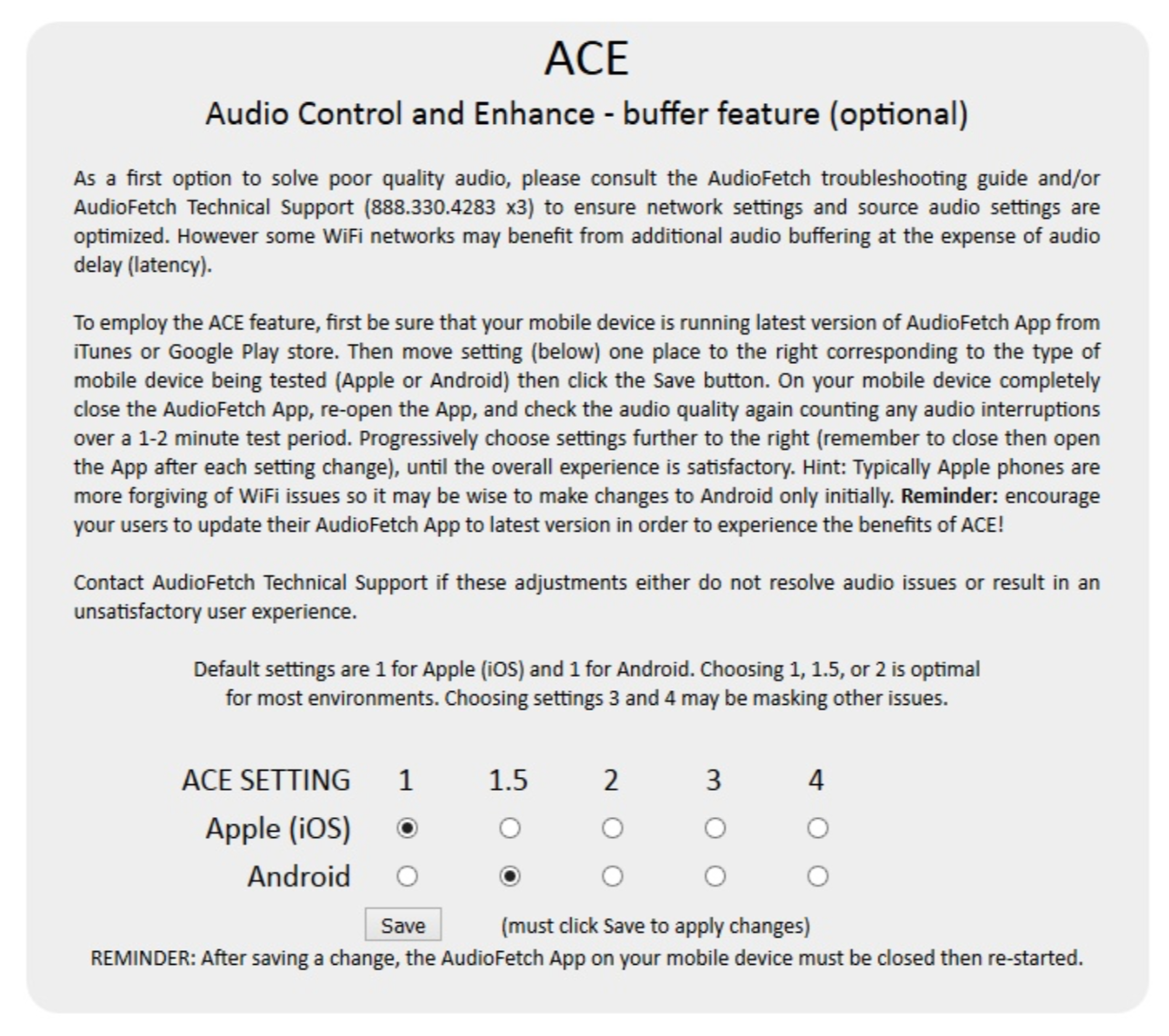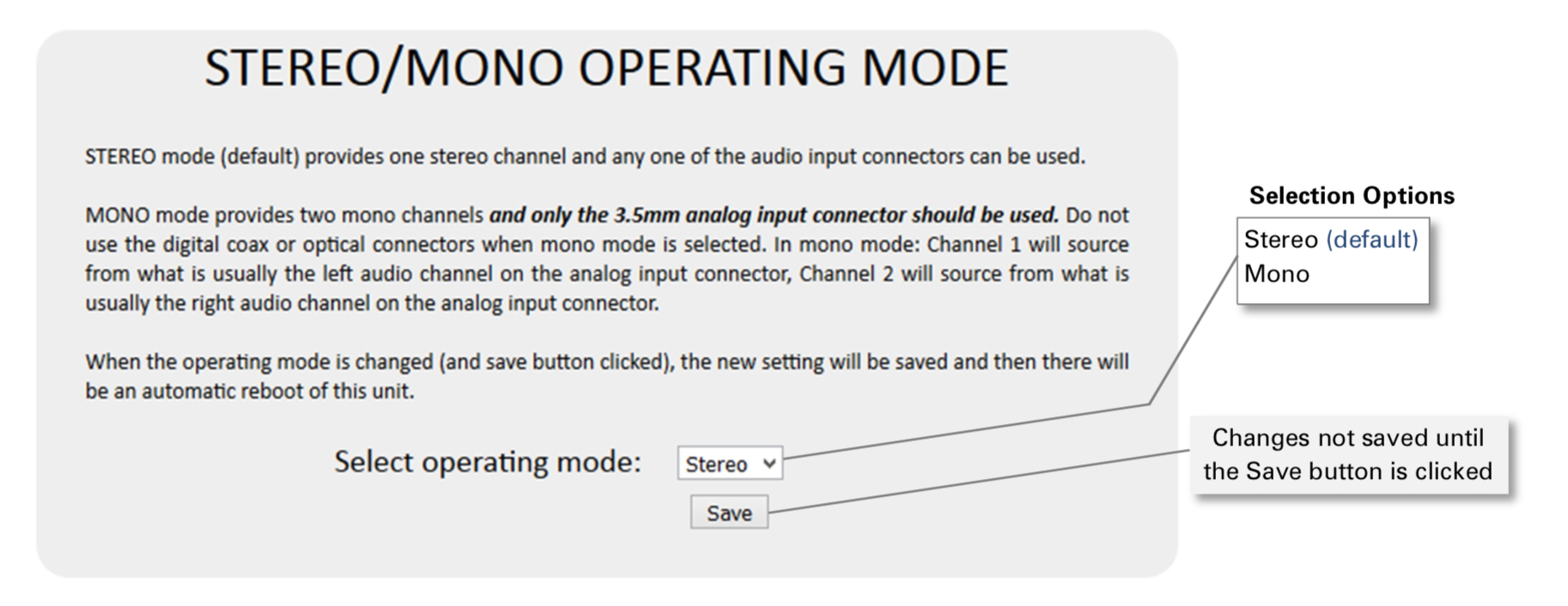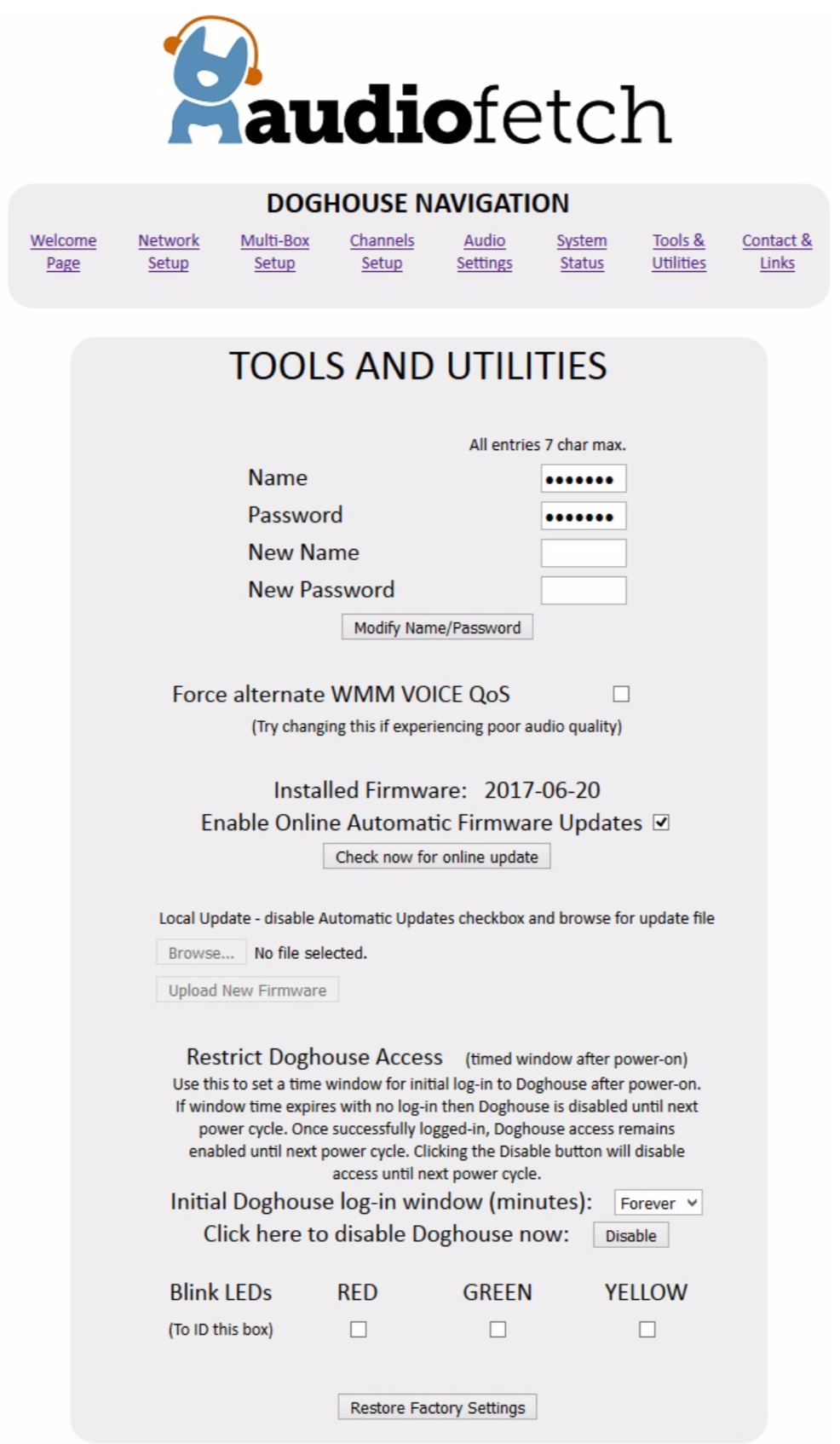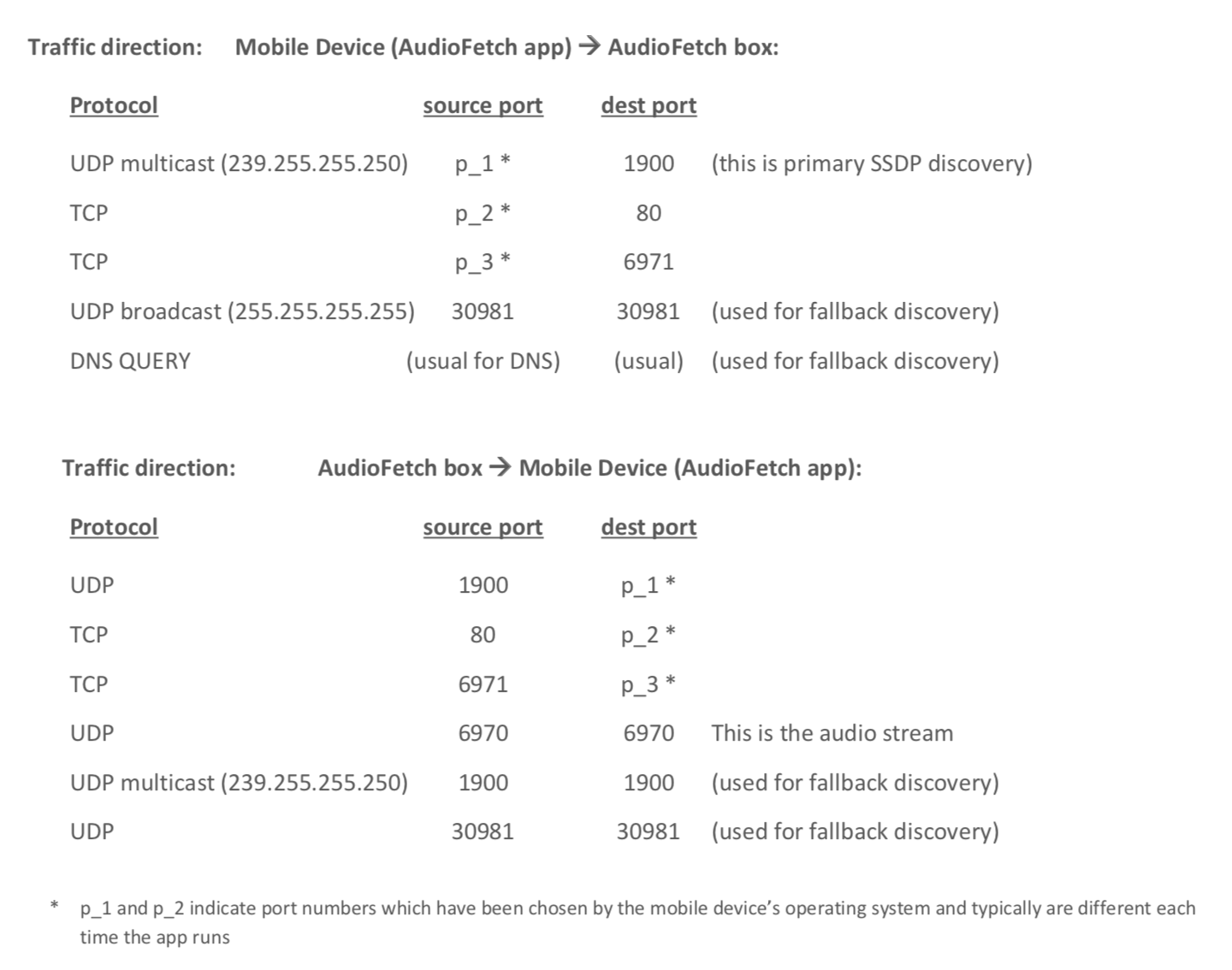FetchExpress User Manual
Click the button to download a printable PDF copy, or find the full FetchExpress User Manual below.
[button color=”accent-color” hover_text_color_override=”#fff” size=”medium” url=”https://www.audiofetch.com/wp-content/uploads/2018/11/FetchExpress-User-Manual-rev-2020-05-12.pdf” text=”Download User Manual” color_override=””]
Contents
- The AudioFetch App
- AudioFetch “Swag” – TV Signage, Table Tents, Cardio Clings and Window Decals
- The Free AudioFetch Ad Portal
- AudioFetch Express Connectors and External Button
- Connecting Power
- Connecting AudioFetch Express to Audio Sources
- AudioFetch Express LED Indicators
- Networking Modes
- Configuration Management
- Restoring Factory Defaults
- Changing SSID/Password in Wireless Client Mode
- Reference Information – Network Traffic
- Regulatory Compliance Statements
AudioFetch Express is a compact cost effective solution delivering high-quality low-latency audio from TVs, STBs, or other audio sources via WiFi to personal mobile devices such as smartphones and tablets.
The integrated WiFi is by default configured as an Access Point. Or the AudioFetch Express can be connected wired or wirelessly into a pre-existing WiFi network enabling greatly simplified installations in fitness clubs, sports bars, movie theaters, waiting rooms, meetings, conventions or wherever users need convenient access to in-house audio sources.
Note: If no specific cables or lengths are requested the following will be provided: 6’ RCA to 3.5mm jack (audio), USB A to mini-B (for power)
Additional cable lengths and types are available at: www.monoprice.com.
Please call technical support at 888.330.4283 x3 if you assistance.
1. The AudioFetch App
Download the latest AudioFetch app for free from the Google Play® or Apple iTunes® store. Familiarize yourself with the drop down menu including the help menu section should it be needed during installation.
2. AudioFetch “Swag” – TV Signage, Table Tents, Cardio Clings and Window Stickers
Post the provided signage on the TVs. Cardio clings, table tents and door/window stickers are provided to enable patrons to easily obtain and use the AudioFetch app.
3. The free AudioFetch Ad Portal
The AudioFetch app displays custom ads and notices which can be managed from the cloud. Log in to the ad portal at www.audiofetch.com/portal using the username and password provided with your order to post your ad/info graphic that can direct users to your website, an e-mail address, and/or phone number that you specify. Add multiple graphics that rotate through at the time duration you specify.
Call 888.330.4283 x3 to confirm your log-in credentials if needed.
4. AudioFetch Express Connectors and External Button
5. Connecting Power
The AudioFetch Express receives power from any USB port capable of providing 500mA (or more) of current. Most USB ports on the back of TVs are capable of providing this power. For non-TV applications a USB power adapter can be included, please discuss with AudioFetch when placing an order.
Connect the provided USB-A to Mini-B 5pin cable between the AudioFetch Express Power Input connector and a USB port capable of providing 500mA. There is no power switch, the AudioFetch Express will power up whenever the USB port is powered. Should the AudioFetch Express need to be power-cycled , simply unplug the USB cable for one or more seconds then plug it back in again.
Longer USB cables can be ordered from: www.monoprice.com or www.amazon.com. Be sure to search for and order only cables with 24AWG conductors for the power lines, as smaller conductors may cause problems with AudioFetch Express operation. Here is an example for an acceptable 15-ft USB cable: 15-Feet USB 2.0 A Male to Mini-B 5pin Male 28/24AWG Cable.
6. Connecting AudioFetch Express to Audio Sources
Connect an audio source to one of the 3 input options, choose only one input connection.
Two popular analog connections on TVs are RCA (one red and one white) or a 3.5mm stereo jack (headphone jack). Either one can be connected into the Analog input of AudioFetch which is a 3.5mm stereo jack. Digital connection options are optical and digital coax.
Note that RCA and digital coax connections are not the same. A digital coax output (on TV, etc.) cannot connect into the AudioFetch Express analog input. An RCA analog output (from TV, etc.) cannot connect into the AudioFetch Express digital coax input. The configuration management pages can be logged into as described below to determine if a good audio signal is connected into the channel.
When connecting via digital inputs, always choose the audio source type (in the TV or STB menu) as PCM since Dolby Digital encoded signals are not supported.

7. AudioFetch Express LED Indicators
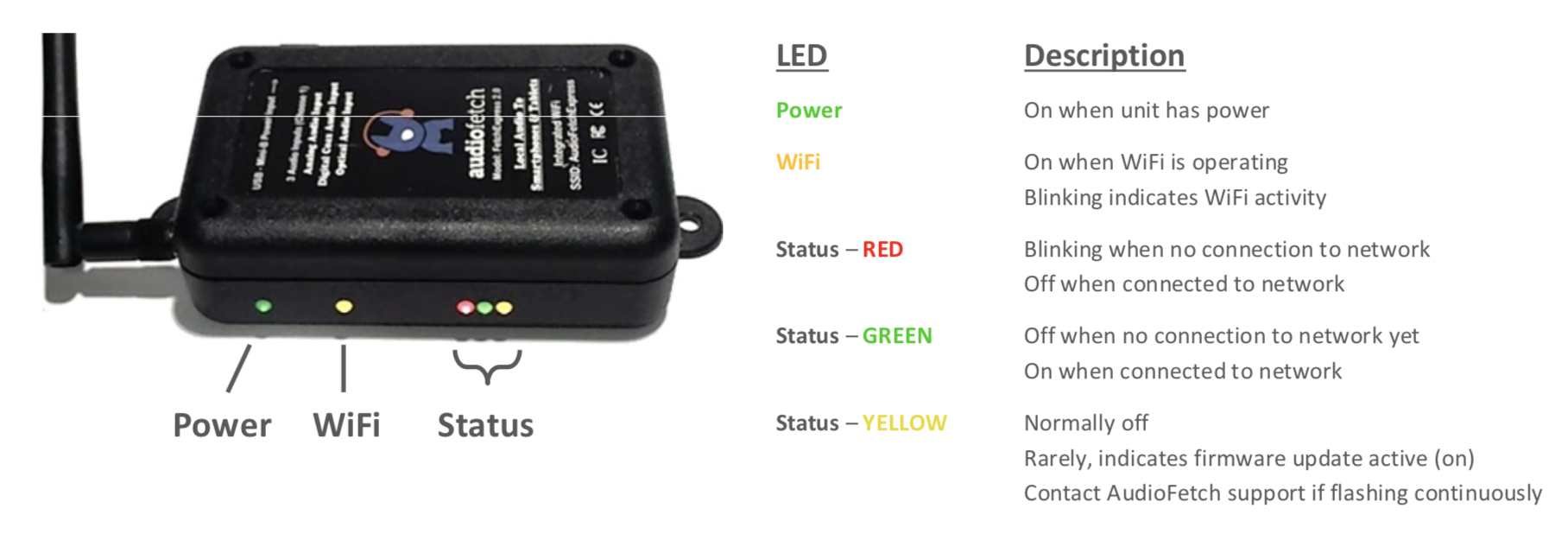 During boot-up (takes about 35 seconds) the LEDs will sequence through different indications. After boot-up is complete the normal operating indication is:
During boot-up (takes about 35 seconds) the LEDs will sequence through different indications. After boot-up is complete the normal operating indication is:
Notes: WiFi may blink to indicate activity on the WiFi connection – this is normal. WiFi will remain off if AudioFetch Express is configured for wired-only operation.
Quick Troubleshooting:
In Wireless Client mode: If Status-RED remains blinking indefinitely, the FetchExpress cannot connect into your existing WiFi network. Things to try or check:
- Check that your existing WiFi network is on and other devices can connect successfully.
- If your WiFi is configured for Captive Portal (there is a splash screen or login page) then the both MAC addresses of the AudioFetch Express must be added your network’s whitelist of clients allowed to bypass the captive portal.
- Try power cycling the AudioFetch Express (as troubleshooting step).
- Try repositioning the AudioFetch Express or your Access Point/Router to check if WiFi signal strength is weak.
- Check that your WiFi SSID and password are correctly configured in the AudioFetch Express – double check information provided to AudioFetch when ordered and if necessary re-configure the SSID/password settings as described in section 11 Changing SSID/password in Wireless Client Mode.
Rarely, AudioFetch Express will receive firmware updates (if connected to the internet). During an update, the yellow status LED will flash irregularly to indicate download in progress followed by the status LEDs going through a number of different sequences (not described here) and finally the AudioFetch Express will reboot and return to normal operation. Note that configuration settings are preserved through this firmware update process.
8. Networking Modes
The AudioFetch Express contains an internal WiFi module capable of operating as an Access Point or connecting into existing WiFi networks. An Ethernet jack is also provided for connections into wired networks. Four networking modes are supported:
- Access Point (with optional wired Ethernet connection for Internet access)
- Access Point with Wireless Internet
- Wireless Client
- Wired Only
A. Access Point
The AudioFetch Express operates as an Access Point and provides its own WiFi network. Mobile devices receive audio by connecting to this WiFi network.
Optional: Internet access can be provided by connecting the AudioFetch Express Ethernet port into a pre-existing network which has internet access (like a WAN connection on a consumer wireless router).
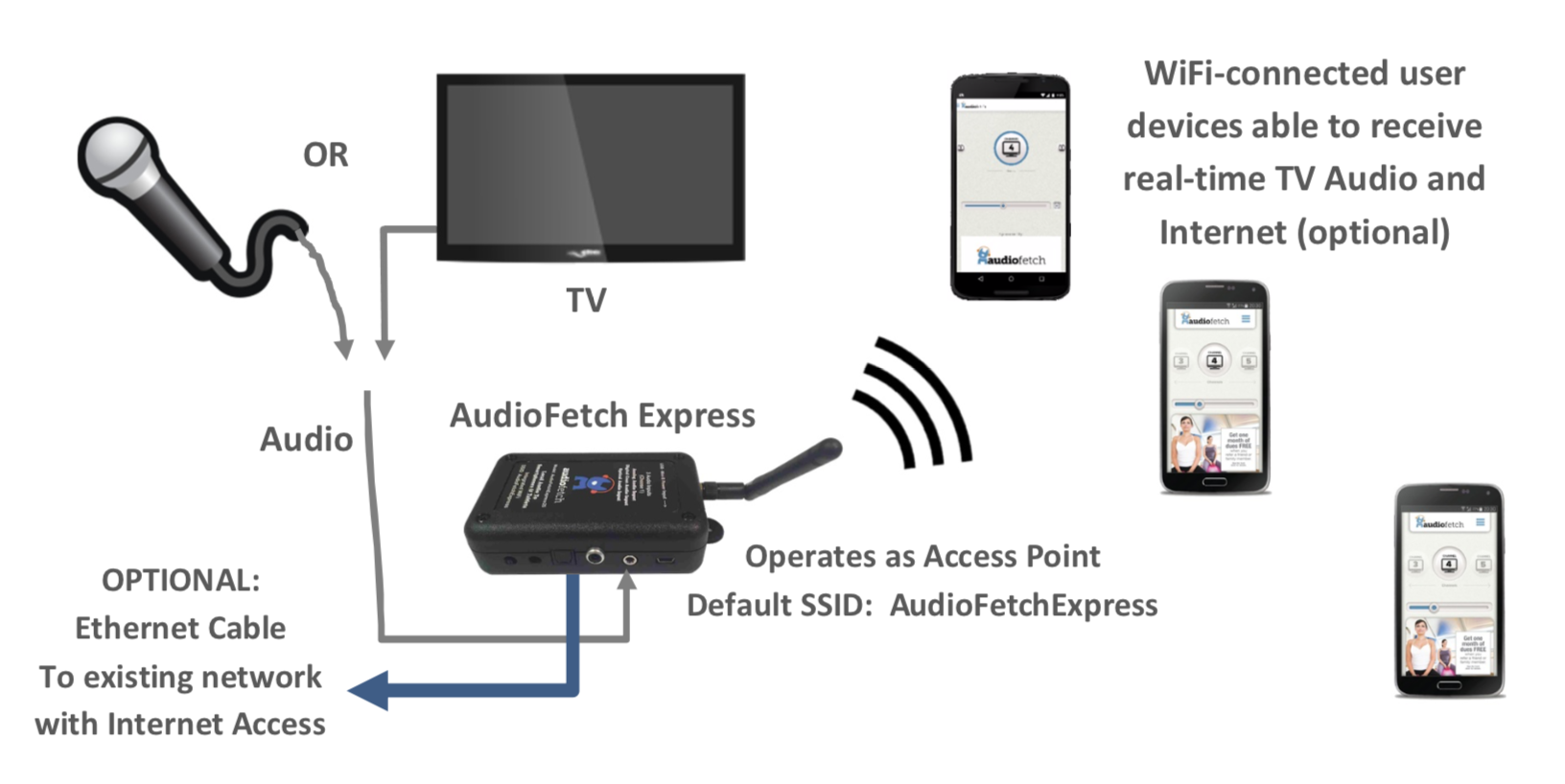 Note: This is the default networking mode – it will be active after factory defaults are restored using the External Button as described in section 10 Restoring Factory Defaults with External Button.
Note: This is the default networking mode – it will be active after factory defaults are restored using the External Button as described in section 10 Restoring Factory Defaults with External Button.
The default SSID is: AudioFetchExpress with no password
B. Access Point with Wireless Internet
The AudioFetch Express operates as an Access Point and provides its own WiFi network. Mobile devices receive audio by connecting to this WiFi network.
The AudioFetch Express connects as a client into a pre-existing WiFi network to provide internet access.
C. Wireless Client
The AudioFetch Express connects to a pre-existing WiFi network as a client. Mobile devices receive audio by connecting to the pre-existing WiFi network.
D. Wired Only
The AudioFetch Express connects to a pre-existing wired network via its Ethernet connector. Mobile devices receive audio by connecting to the pre-existing WiFi network.
The pre-existing WiFi network provides internet access.
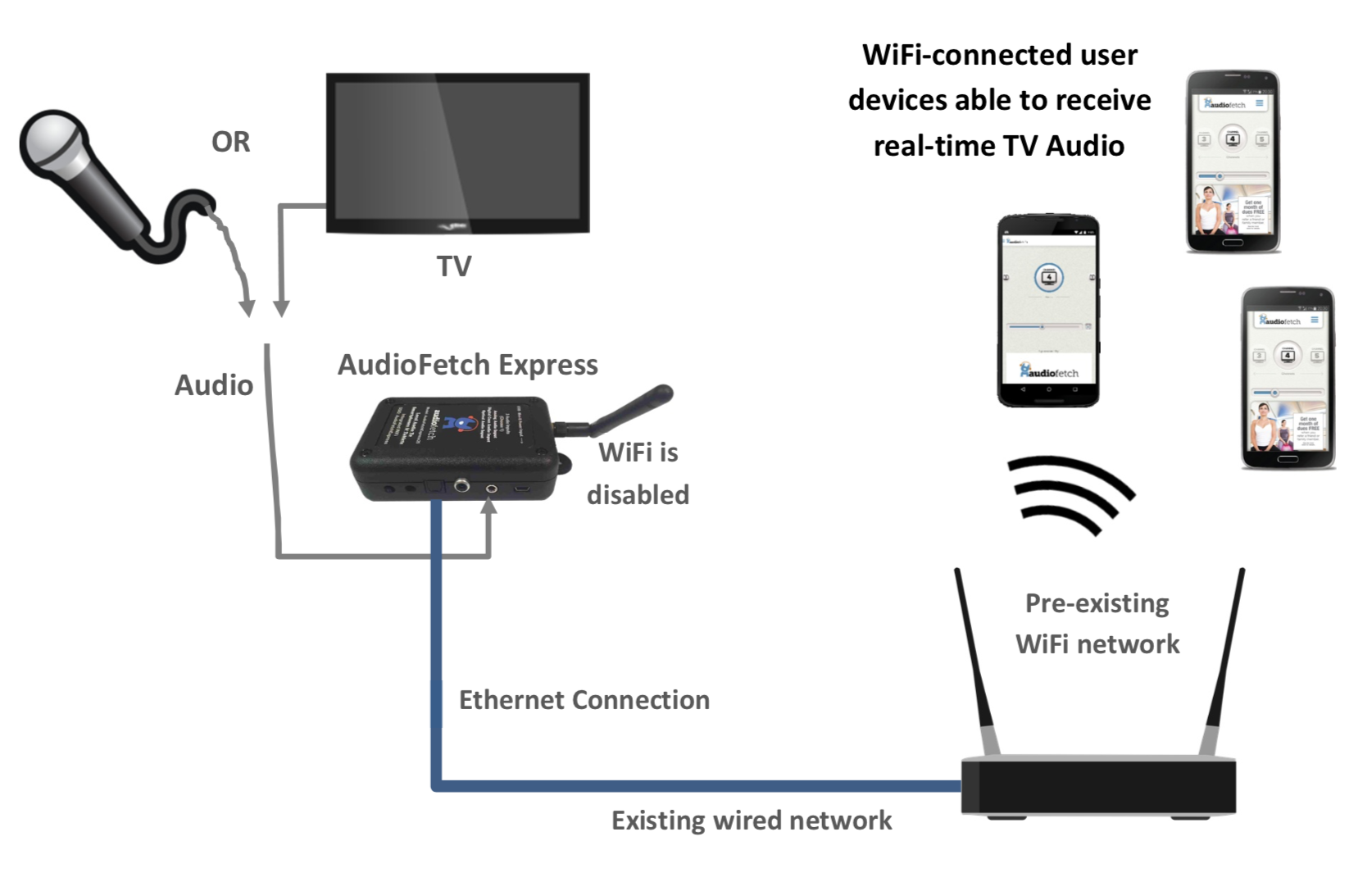 Typically, AudioFetch Express is shipped pre-configured for correct network mode, but only if complete information is provided about your network and installation requirements when ordering.
Typically, AudioFetch Express is shipped pre-configured for correct network mode, but only if complete information is provided about your network and installation requirements when ordering.
Networking mode can be re-configured in the Doghouse if needed.
9. Configuration Management – “The Doghouse”
9.1 Introduction to the Doghouse and Doghouse Utility App
Configuration settings (“The Doghouse”) for each AudioFetch box are viewed using a web browser on a device (PC, tablet, mobile phone, however not compatible with MAC) which must be connected to the same network as AudioFetch Express.
Most applications do not require access to the Doghouse since the default settings are adequate. When adjustments are required, please review information in this section.
The “Doghouse Utility App” can be used to search for AudioFetch boxes on the network and provide easy one-click access to the Doghouse for each box. The Doghouse Utility App is available for Windows, Android, and iOS (not available for MAC), further information and install links can be found here: www.audiofetch.com/doghouse
First, ensure your device (PC, mobile phone, tablet, etc.) is connected to the same network as AudioFetch Express.
On a Windows device: Install then run the Windows version Doghouse Utility to locate AudioFetch box(s) on the network. The Windows version Doghouse Utility looks like this:
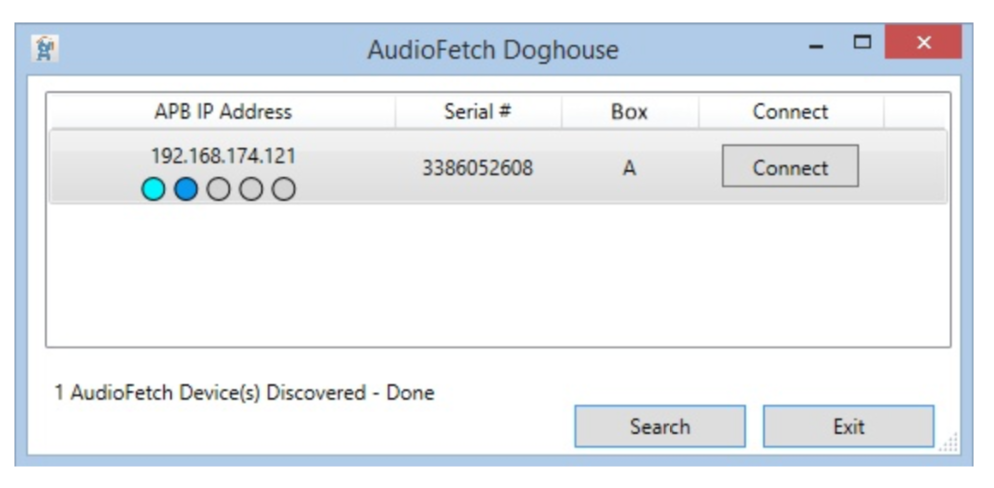 On Android or Apple (iOS) devices: Search and install “AudioFetch Doghouse” in the Google Play® (Android OS devices) or Apple iTunes® (Apple devices with iOS operating system) store, direct links to the store locations are provided on the web page referenced above.
On Android or Apple (iOS) devices: Search and install “AudioFetch Doghouse” in the Google Play® (Android OS devices) or Apple iTunes® (Apple devices with iOS operating system) store, direct links to the store locations are provided on the web page referenced above.
Here is an example screenshot of the Apple version Doghouse App (Android looks similar):
In AudioFetch systems employing more than one AudioFetch Express box (or a mix of standard/wired AudioFetch boxes and AudioFetch Express boxes), all of the boxes present should appear in the listing, like this example from the Windows Doghouse Utility:
Each box has its own configuration settings, in other words each box has its own independent Doghouse. When installing a system with multiple boxes, each Doghouse must be accessed in order to configure each of the boxes correctly.
9.2 Doghouse Login
Once the AudioFetch box(s) are displayed, click the “Connect” button (Windows) or tap in the information area for the box (Android/Apple) to open the Doghouse for the desired box in your default web browser. A login dialog will be displayed (this is the Windows version, Android/Apple will look different but request the same info):
Your username and password are included in the product manual shipped to you. If you need a new username/password, please contact us by calling 1-888-HI-FETCH or sending a note here.
9.3 Welcome Page and Basic Navigation
After successful login you will see a welcome page similar to below:
Use the links in the NAVIGATION section to access each of the configuration pages.
9.4 Network Setup Page
The NETWORK SETUP Doghouse Page configures the network operating modes and provides additional network-related information (such as MAC addresses):
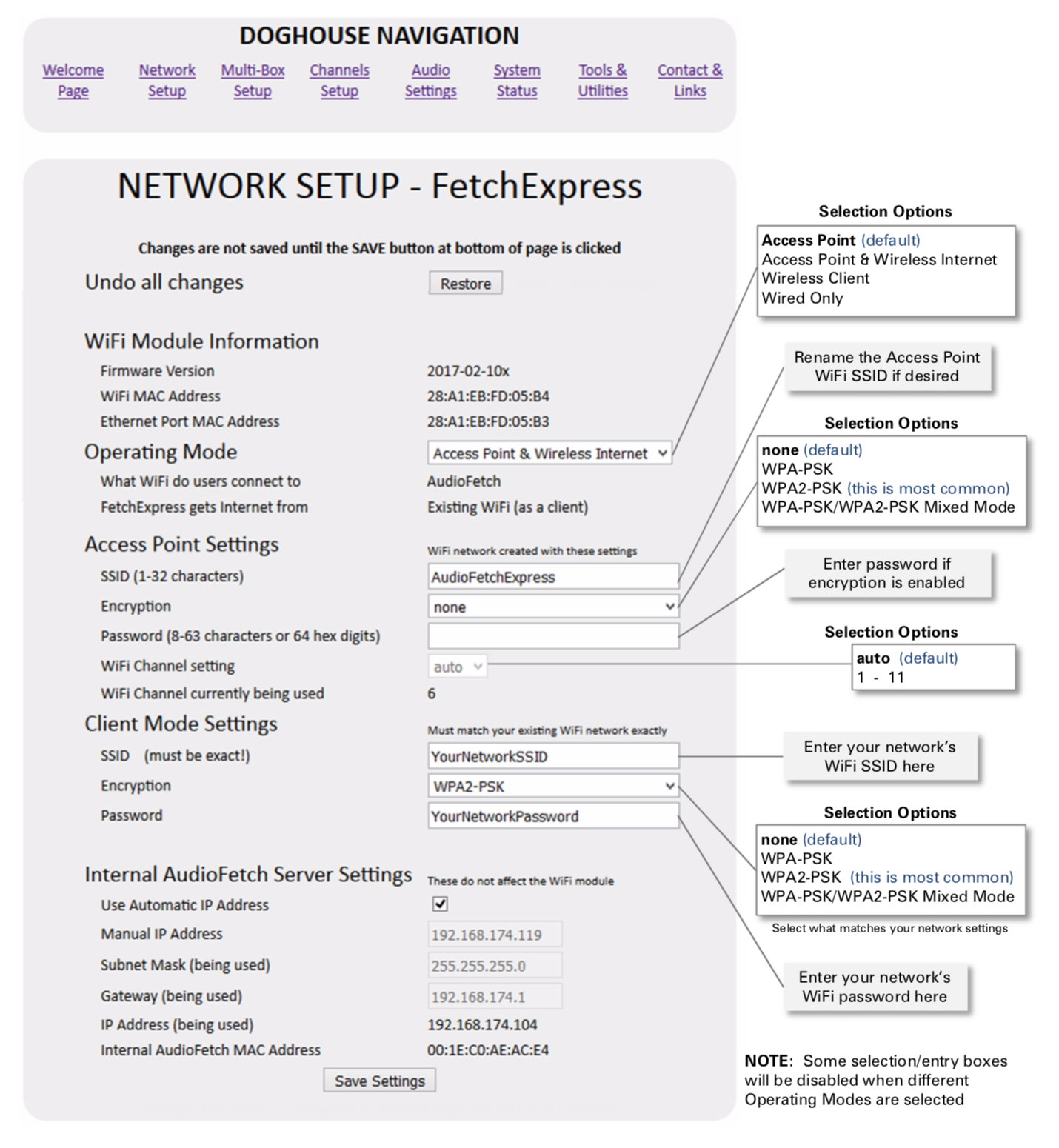 Important points when using the NETWORK SETUP page to reconfigure the network settings:
Important points when using the NETWORK SETUP page to reconfigure the network settings:
- Changing to a new Networking Mode will almost certainly cause your browser to disconnect from the Doghouse (after clicking the “Save Settings” button)
- You will need to reconnect your PC/device to the AudioFetch Express via the new networking mode, in order to re-establish access to the Doghouse (just like starting from scratch)
- Any mistake made in the settings, could cause the AudioFetch Express to become inaccessible after the “Save Settings” button is clicked
- For any problem, best course of action is:
- Use the red External Button to restore factory defaults in the Wi-Fi Module as described in section 10 Restoring Factory Defaults with External Button
- Reconnect to the default AudioFetch Express Access Point (SSID: AudioFetchExpress) o Access the Doghouse
- Start over again entering the desired new network configuration settings
Steps to reconfigure the network mode:
- Connect to the AudioFetch Express (AFE) and access the Doghouse via the current networking mode
- In Access Point mode: Access the Doghouse through the AFE’s Wi-Fi network
- In Access Point & Wireless Internet mode: Access the Doghouse through the AFE’s Wi-Fi network
- In Wireless Client mode: Access the Doghouse through the pre-existing Wi-Fi network
- In Wired Only mode: Access the Doghouse through the pre-existing wired or Wi-Fi network
- Adjust the desired setting
- Nothing is activated or saved until the “Save Settings” button is clicked
- Carefully review the settings
- Click the “Save Settings” button and review the warning dialog that pops up
- Click the “OK” button in the warning dialog
- The Status LEDs to begin a “marching” pattern to indicate the save is still in- progress. The march will be: yellow, green, red, repeat….
- The save will take some time, be patient and do not disconnect power
- Then the AudioFetch Express will automatically restart and should begin operating in the new mode
- After the reboot, the new networking mode should be active and if correctly configured the status LEDs should indicate the ready condition
- If any problem after the reboot (ie: new networking mode doesn’t seem to work), then:
- Try is a power cycle (wait at least 35 seconds after cycling power before trying to access again)
- Use the red External Button to restore factory defaults in the Wi-Fi Module as described in section 10 Restoring Factory Defaults with External Button, then repeat this procedure
The NETWORK SETUP page is designed to be as foolproof as possible:
- Only those settings applicable for the selected Networking Mode will be available for editing (automatically grayed out if not applicable)
- Once any setting is changed, a warning notice will appear that the new settings have not been saved. This warning will persist until one of the following occurs
- Restore button is clicked
- Save Settings button is clicked and OK is clicked in the warning dialog
- There is a “Restore” button that undoes all the changes
- A warning dialog will automatically display if the Save Settings button is clicked and any required settings are missing
- For example: if encryption has been enabled but no password entered
The lower section of the NETWORK SETUP page configures settings of the internal AudioFetch audio server. Check “Use Automatic IP Address” to have the AudioFetch audio server receive its’ IP address automatically (from the network’s DHCP server), this is the recommended setting. Or uncheck and enter values for: Manual IP Address, Subnet Mask, and Gateway.
The values must be correct for operation with the connected network, contact your IT network administrator for instructions if needed.
Usually it is best to leave “Use Automatic IP Address” enabled and let the network’s DHCP server assign an IP address. It is not necessary to enter a manual IP address when the network’s DHCP server has been configured with a reservation IP address for the AudioFetch Box, just leave Use Automatic IP Address enabled – the DHCP server should be able to assign the reserved IP address based on the AudioFetch Express’s MAC address.
IMPORTANT NOTE FOR IT PERSONNEL: In Wireless Client networking mode, the AudioFetch Express will present two distinct clients to the pre-existing WiFi network. One client is the internal WiFi module (operating in a bridging mode) and the other client is the AudioFetch Express device (which serves the audio). Both clients will request (and should receive) individual IP addresses from the DHCP server. If using Wireless Client mode and experiencing connectivity issues please request the AudioFetch App Note: “AudioFetch Express Wireless Client Networking Info,” which explains in greater detail. Contact AudioFetch Technical Support if further assistance is required.
After any changes are made on the NETWORK SETUP page, the “Save Settings” button at bottom of page must be clicked in order for the new settings to take effect. When the Save Settings button is clicked, the settings are saved and then the AudioFetch Express box will automatically restart. If DHCP assigns a new/different IP address after the restart, then use the Doghouse Utility again to re-connect to the Doghouse (if needed).
9.5 Multi-Box Setup Page
Where more audio channels are required, multiple AudioFetch Express (and/or wired AudioFetch) boxes can be connected to the same network (called Multi-Box installation). Up to 32 boxes total may be used in an AudioFetch system. When multiple AudioFetch Express units are used in Wireless Client mode most WiFi Access Points will support a smaller quantity simultaneously. The recommended maximum number of AudioFetch Express units connected in Wireless Client mode is 8.
The MULTI-BOX SETUP page is used to configure AudioFetch to work correctly in multi-box installations.
Most AudioFetch installations are single-box, in this case ensure that “BOX A” is selected from the drop-down list – as shown in the image above (this is the factory default setting).
In multi-box installations, the AudioFetch App needs to know how to coordinate the order of channels it displays with channels from each of the AudioFetch boxes present. This is accomplished by designating the AudioFetch boxes present as:
- BOX A
- BOX B
- BOX C
- BOX D . . .
- (32 choices, up to BOX AF)
The channels from BOX A will be displayed first by the AudioFetch App, channels from BOX B will be displayed next, etc.
For example, in a 2-box installation where a 16-channel box has been designated BOX A and a 4-channel box has been designated BOX B, the channels will be displayed by the App like this:
Note that the system default channel numbers are shown in the example above – channel 17 is displayed for BOX B and channel 33 for BOX C due to system compatibility requirements with other types of AudioFetch boxes (such as a 16-channel box). If channel names have been assigned in each of the AudioFetch Express Doghouses, the channel names will be displayed by the app instead of default channel numbers shown above, but the ordering will still be determined by the BOX A/B/C designation.
Each AudioFetch Express box must be separately configured with a BOX A/B/C/D… designation. If two or more boxes have the same designation letter, then the system will not operate correctly. Configuring unique BOX designations is mandatory in multi-box installations!
IMPORTANT: Each box must have a different designation!
Note: When multiple AudioFetch boxes are ordered to work together on the same network, they will be pre-configured for you and this procedure will not be necessary.
To configure the boxes in a multi-box installation:
- Decide how you want the channels from each box to be ordered by the App (which box’s channels display first, second, third, etc.).
- Use the Doghouse Utility to find/display all of the boxes on the network.
- Access the Doghouse for the first box (You want the App to display this box’s channels first), navigate to the MULTI-BOX SETUP page and use the drop-down selector to select “BOX A”, the new setting is saved automatically.
- Access the Doghouse for the second box, navigate to the MULTI-BOX SETUP page and use the drop-down selector to select “BOX B” (new setting automatically saved).
NOTE: Each box has its own Doghouse, you must access each box’s Doghouse separately.
- If a third box is present: access the Doghouse for the third box, navigate to the MULTI-BOX SETUP page and use the drop-down selector to select “BOX C.”
- If a fourth box is present: access the Doghouse for the fourth box, navigate to the MULTI-BOX SETUP page and use the drop-down selector to select “BOX D.”
- Continue this procedure for any additional boxes present.
To assist in setup, the Doghouse MULTI-BOX SETUP page contains a link to detect/display info about other boxes present on the LAN. Click the link, and then a notification page will appear for about 5 seconds while the other boxes are being detected. Then the MULTI-BOX SETUP page will display again with the list of boxes filled out. See the example below which shows the detection results for a 3-box system.
When the drop-down selector is used to change the box designation, the list of other boxes is cleared. In this case just click the detection link again to re-display all the boxes.
After detection, the box setting for each will be displayed as shown above (in the column labeled “Setting”). When configuring a multi-box system, use the detect link to double-check that all boxes have different/unique designations. For example, this display of detected boxes indicates a problem because two boxes are set to the same designation: 
In this case, one of the conflicting boxes should be changed to BOX C.
Note that other-box detection in the Multi-Box Setup page works only on networks which fully support SSDP discovery protocol. Some network configurations do not, in this case use the Doghouse Utility as an alternative to discover all the boxes on the network and display their
box settings.
9.6 Channels Setup Page
The CHANNELS SETUP shows the installed channels and allows alternate names/numbers to be assigned for each channel. The “Enable” checkboxes can be used to disable individual channels – the App will no longer display any which are un-checked.
The default channel number displayed by the App may be replaced by making an entry in the “Name” field such as the entry “ESPN” shown in the example below. Although up to 10 characters may be entered in the Doghouse, the App will display only the first five characters of the channel name entry.
IMPORTANT: The “Save Settings” button must be clicked after any changes are made, otherwise the new settings will be lost at navigation away from this page or the next power cycle. 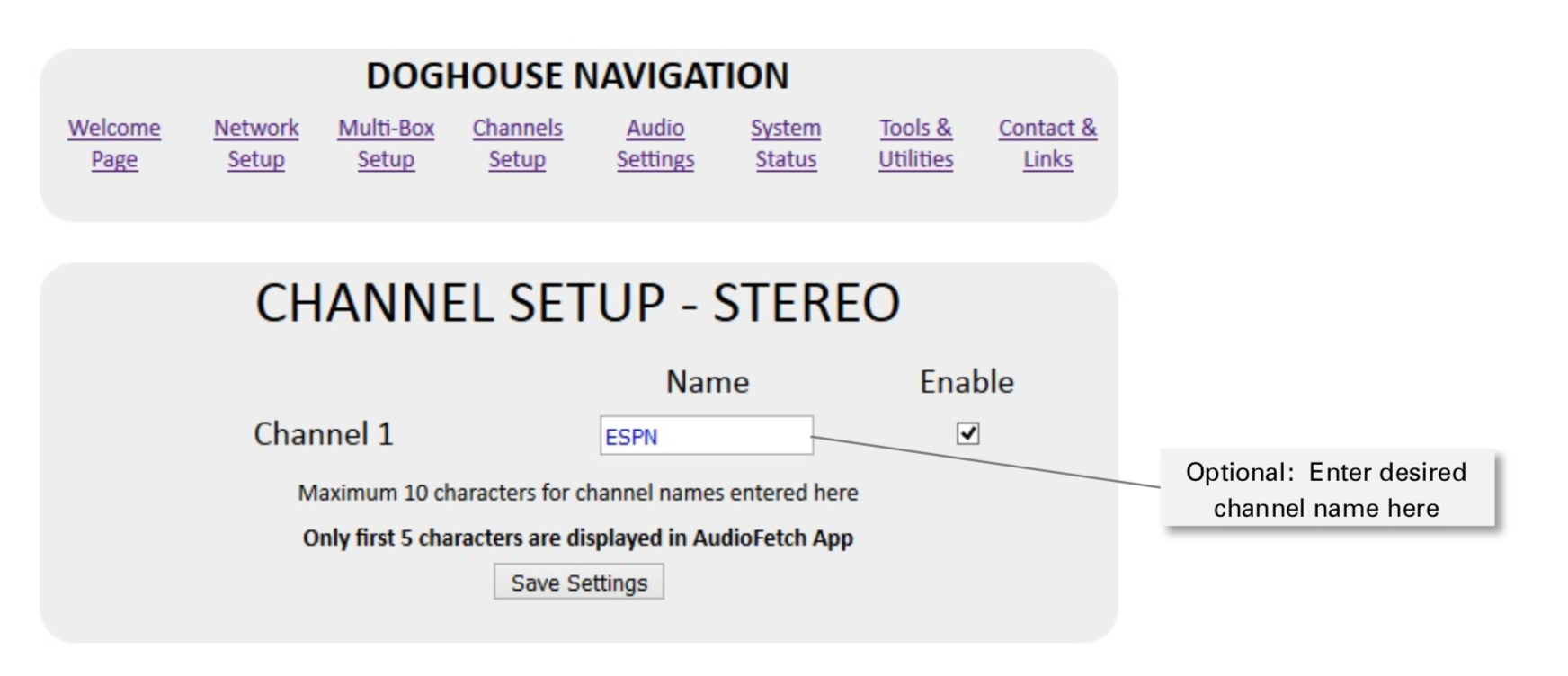
9.7 Audio Settings Page (gain, microphone, ACE feature, STEREO/MONO mode)
The AUDIO SETTINGS page is used to access three different sets of configurations:
- AUDIO GAIN
- PUBLIC ADDRESS
- ACE (Audio Control and Enhance)
The AUDIO GAIN section displays current audio status for the channel selected from the drop-down list, and allows the gain to be adjusted.
To set the Audio Gain:
- Select the desired channel to adjust from the drop-down list
- Ensure an audio source is connected to the corresponding input on the box.
- Monitor the Peak Audio Status number, if an active audio source is connected then it will constantly change.
a. NOTE: There will be no status indicated if the selected channel is not enabled in Doghouse Channels Setup page
b. If the Audio Gain setting is very low (a large negative number) then this might be the problem – try changing the Audio Gain setting to a number like 15 (positive fifteen)
c. If it remains at 0% then check if enabled in the Channels Setup page, check the audio connections, else something is likely wrong in the cabling or audio source - Optimum Peak Audio Status is when the status hits 60% to 85% at its maximum
- If Peak Audio Status is too low or too high, enter a new value for Audio Gain. Values entered can be numbers like 7 or 9.0 or 12.5 (the tenths digit can only be “0” or “5”). Acceptable range is -100.0 to 20.0. Press the Enter key or click the “Save” button to set/save the new gain value.
a. After saving, you should notice a corresponding change in the Peak Audio Status level immediately
b. Keep adjusting the Audio Gain until Peak Audio Status is within optimum range - Repeat this procedure for all audio channels
The example presented above shows an Audio Gain setting of 12.5 and resulting Peak Audio Status of 83.9% (this will change continuously).
MICROPHONE INPUT:
The AudioFetch Express Analog Input connector normally accepts a 3.5mm stereo plug with line-level stereo signal. By checking the “Microphone Enable” box in the AUDIO GAIN section, the Analog Input is reconfigured to accept a condenser style microphone and provide 4.7V (through 3.9K resistor) phantom power to the microphone.
The microphone used must be a type compatible with standard PC sound card mic input, with powering requirements compatible with the 4.7V phantom power (through 3.9K resistor) provided by the AudioFetch Express. AudioFetch recommends the Pyle PLM31 Cardioid Condenser Headset microphone, readily available through many online retailers. Some less expensive microphones available online do not work very well with issues such as low output, distortion, etc.
Note that most headset and sound card compatible microphones offer output on a mono-style 3.5mm plug – the AudioFetch Express is compatible with this – when the Microphone Enable box is checked the microphone’s mono signal is automatically directed into both the right and left audio channels.
To use a microphone with AudioFetch Express:
- Connect a compatible microphone to AudioFetch Express Analog Input
- Access the Doghouse and navigate to the AUDIO SETTINGS page
- Check the Microphone Enable box, the new setting takes effect immediately
- Initially, the “Mic Gain Boost” box should be un-checked
- Position the microphone and speak into it as the microphone will be used normally, speaking a bit louder than will normally occur
- While monitoring the Peak Audio Status indicator, adjust the Audio Gain up or down as needed to achieve maximum peak audio level between 60% to 80%
- If the peak audio level is still too low with Audio Gain adjusted to its maximum setting of 20, then check the Mic Gain Boost box and re-adjust Audio Gain to achieve desired peak audio level
Most headset style microphones are designed to be located close to the speaker’s mouth in which case the microphone produces a strong output signal and the Mic Gain Boost box does not need to be checked. The Mic Gain Boost is intended for situations where the microphone might be located further away from the speaker such as a desktop/podium microphone (remember: the microphone must be compatible with standard PC sound card input). Please use the Mic Gain Boost feature carefully – follow the procedure above – enabling it with strong microphone signal could result in audio distortion.
ACE:
The ACE section (please scroll further down on the AUDIO SETTINGS page) provides optional adjustments which can improve audio quality in facilities where network/WiFi conditions may not be optimum for AudioFetch. Increasing the ACE setting will increase the amount of audio buffering used by the AudioFetch App – this can improve audio quality at the expense of slightly more latency (more delay between on-screen video and the audio heard by users). Usually the latency is not noticeable for ACE settings 1, 1.5, and 2. The latency may be just slightly noticeable for higher settings, but not so much in a fitness club or sports bar environment. Please review the displayed information and instructions, then contact AudioFetch Technical Support if further assistance is needed with the ACE settings.
The STEREO/MONO OPERATING MODE section allows the AudioFetch Express to be configured for either STEREO or MONO operation. MONO operation provides an additional channel at the expense of having only mono signals delivered to the AudioFetch App.
STEREO operation:
- A single channel will appear in the Channels Setup page
- One stereo channel will be available in the AudioFetch App
- Any of the audio input connectors may be used (Optical, Digital Coax, Analog)
MONO operation:
- Two channels will appear in the Channels Setup page
- Two mono channels will be available in the AudioFetch App
- The Analog input connector must be used – do not use Optical or Digital Coax inputs!
When the mode is changed and Save/OK buttons clicked, the new mode will be saved and the AudioFetch Express will automatically reboot, which will take about 45 seconds. During this time do not remove power from the AudioFetch Express.
When configured for MONO operation, the Analog input connector must be used, do not use Optical or Digital Coax inputs. The Analog input connector is a standard 3.5mm stereo jack, in mono mode the signal coming in on what is usually the Left connection (in stereo operation) will be directed to Channel 1 in the App, the signal coming in on what is usually the Right connection will be directed to Channel 2 in the App. Choose the appropriate cables and adapters to route the separate source audio signals into the L/R signals of the Analog input connector. Contact AudioFetch Support if further help is required for making the signal connections.
9.8 System Status Page
The SYSTEM STATUS page shows basic information about the system and connected users (see example on next page). Not all information is refreshed automatically, click the “Refresh” button at the bottom of the page to update the display of latest status.
Click the “Reset Statistics” button to reset the general statistics in the upper area.
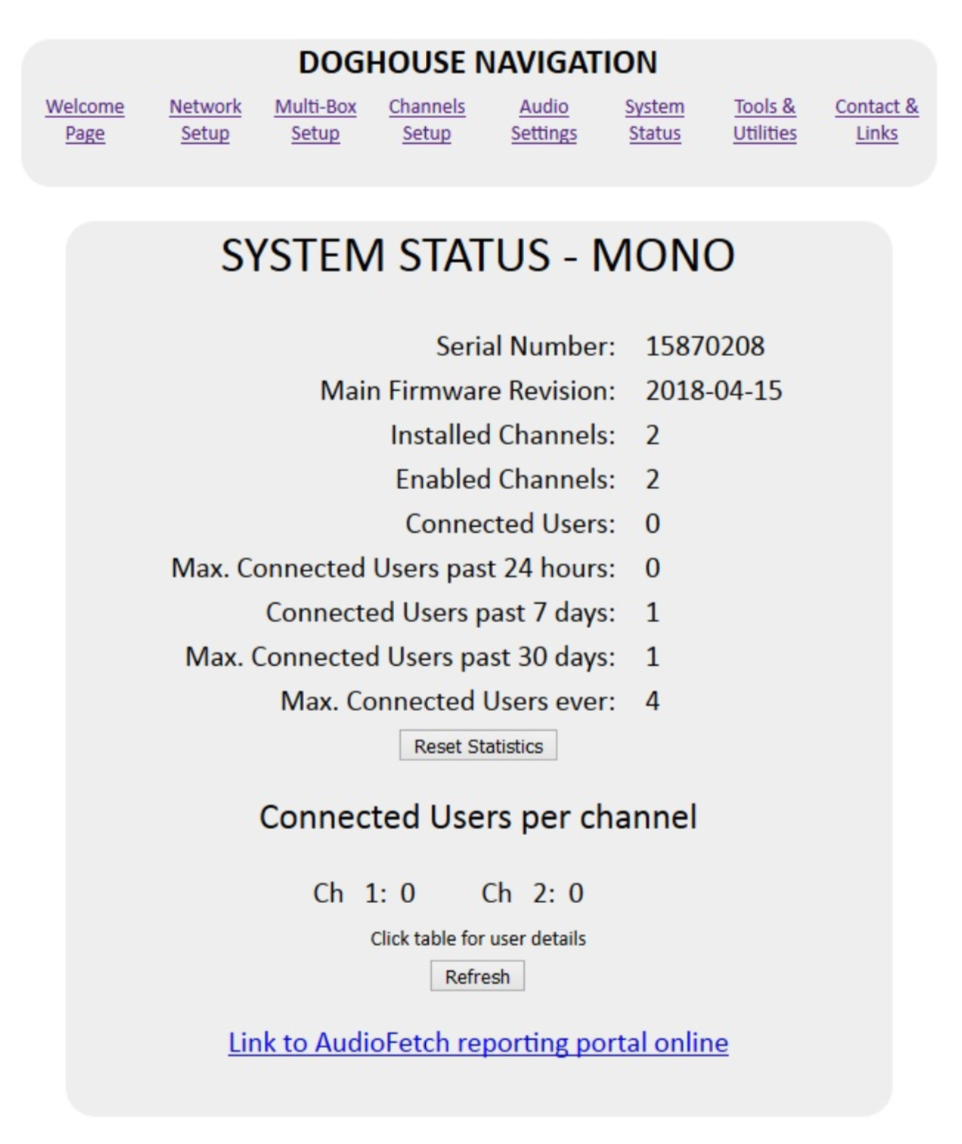 Click anywhere in the “Connected Users per channel” area and a detailed list of currently connected users is displayed with various sorting options provided by the drop-down selector:
Click anywhere in the “Connected Users per channel” area and a detailed list of currently connected users is displayed with various sorting options provided by the drop-down selector: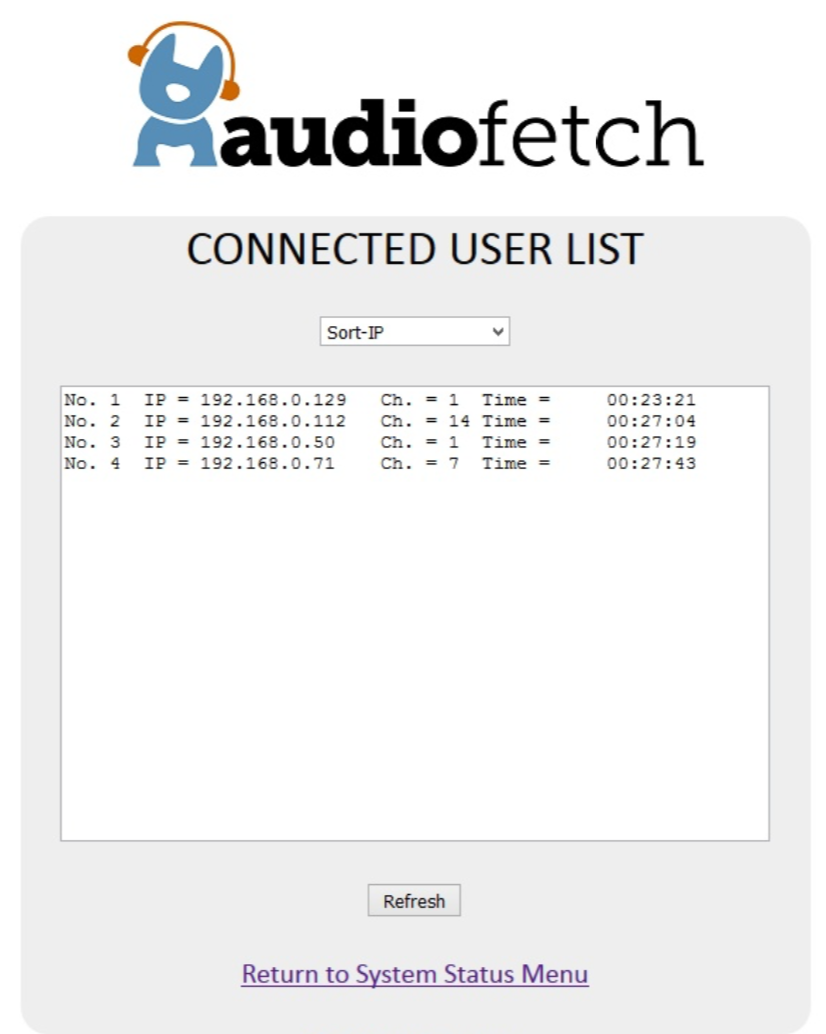
AudioFetch provides additional monitoring statistics online, click the link at the bottom of the SYSTEM STATUS page to access the online reporting service. Contact AudioFetch Support if you have lost or forgotten your online login credentials.
9.9 Tools and Utilities Page
The TOOLS AND UTILITIES page provides means to change the Doghouse username/password, an alternate QoS adjustment which can improve audio quality on some networks, settings related to how automatic firmware updates are delivered, and other utility functions.
To change username/password, enter the current credentials into the first two boxes, then enter the new username/password into the last two boxes and click the “Modify Name/Password” button.
The “Force alternate WMM VOICE QoS” checkbox should be used when experiencing audio quality issues – especially on busy networks. Experiment with this setting to determine if it can improve audio quality. Expected behavior is that audio will be better with this box un-checked on networks using Cisco equipment, and better with this box checked on networks using non-Cisco equipment. But this is not certain and one should experiment to determine which setting produces the best audio quality.
There is a checkbox to enable/disable Online Automatic Firmware Updates, which are provided from time to time by AudioFetch (the box must be connected to a network with Internet access). Default setting is enabled, AudioFetch recommends this be left enabled. AudioFetch system firmware updates are rare and generally occur late at night. The AudioFetch box checks for an available update once just after power-on and then once every 5
hours thereafter.
If desired, the “Check now for online update” button may be clicked. A confirmation will pop up, click the “OK” button to proceed. There is no subsequent display about an update being available or starting, but if an update is available then it will begin automatically and the download progress is indicated by the yellow status LED on the AudioFetch box flashing (during download). After the download completes, AudioFetch will reset itself, execute the update (yellow LED will turn on again during update), then reboot. Completing all of this typically takes about 10-20 seconds.
New firmware may be manually uploaded to AudioFetch if needed (see buttons near the bottom of the page) but this would be an extremely rare occurrence and should be accomplished while receiving guidance from AudioFetch tech support on a case-by-case basis.
“Restrict Doghouse Access” is a security feature to help prevent unauthorized access into the Doghouse by end users of the AudioFetch system. By default, the Doghouse may be accessed at any time so long as the correct username/password credentials are entered. By selecting a specific log-in window of time from the dropdown box, the Doghouse will only be accessible if the initial log-in occurs within the selected number of minutes after power-on. The choices are: 1 minute, 2 minutes, 5 minutes, 10 minutes, and “Forever”. If an initial log-in does not occur within the selected time window, then the Doghouse becomes and remains completely inaccessible until the next power cycle occurs. For example, if a 1 minute time window is selected, you must log-in to the Doghouse within 1 minute of power-on (it’s actually 1 minute from the time the green status LED turns on solid). Once successfully logged-in, the Doghouse will remain accessible indefinitely, until either: the next power cycle, or the “Disable” button is clicked. If access to the Doghouse is needed again, just power cycle the box and log-in again within the 1 minute window.
The “Blink LEDs” section provides checkboxes for each of the three status LEDs on the AudioFetch box. When any of these checkboxes are enabled, the normal status display is temporarily replaced by the enabled LEDs blinking. This is simply a way to force the status LEDs on a particular box to blink – which can be useful for identifying specific boxes in a multi-box installation. Be sure to uncheck all of these to return the LEDs to normal display of status.
Clicking the “Restore Factory Settings” button clears most AudioFetch Doghouse settings, restoring to factory default values, but does not restore the networking mode settings on the NETWORK SETTINGS page. AudioFetch will automatically reboot after clicking this button. After performing a factory restore, Doghouse settings should be reviewed and adjusted as necessary (don’t forget that the username/password will be reset back to default as well).
NOTE: AudioFetch recommends using the external button to restore factory defaults, as this provides means to restore all settings to default values, including the networking mode settings. Use of the external button is described in section 10 Restoring Factory Defaults with External Button.
9.10 Contacts and Links Page
The CONTACT & LINKS page contains contact information in case support is required, as well as a link to the online portal.
10. Restoring Factory Defaults with External Button
(this info applies to firmware 4018-04-16 and later)
There are two choices:
- Restore only WiFi-related settings
- Restore all settings.
IMPORTANT: Do not remove power during the restore procedure.
A. Restore only the WiFi Module settings in the Network Setup Doghouse page:
- Power up the AudioFetch Express and allow it to fully boot (about 35 seconds)
- Press and hold the User Button, as soon as it is pressed all status LEDs will turn off
- Continue pressing the button continuously for 10 seconds
- At 10 seconds all three status LEDs will turn on solid for a window of 3 seconds
- Release the button while the status LEDs are on to restore defaults for only the WiFi module (just the WiFi module settings on the Network Setup doghouse page)
- Red and green LEDs will turn off, yellow LED will flash indicating WiFimodule restore is in progress
- AudioFetch Express will automatically reboot when restore is complete
- Release the button while the status LEDs are on to restore defaults for only the WiFi module (just the WiFi module settings on the Network Setup doghouse page)
B. Restore all settings on all Doghouse pages:
- Power up the AudioFetch Express and allow it to fully boot (about 35 seconds)
- Press and hold the User Button, as soon as it is pressed all status LEDs will turn off
- Continue pressing the button
- At 10 seconds all three status LEDs will turn on solid for a window of 3 seconds
- Do not release the button yet, continue pressing button and the status LEDs turnoff again
- After the status LEDs turn off, continue pressing button for another 7 seconds
- When all three status LEDs turn on again:
- Release the button while the status LEDs are on to restore factory defaults for allDoghouse settings
- Red LED will turn off, green and yellow LEDs will flash indicating full restoreis in progress
- AudioFetch Express will automatically reboot when restore is complete
- Release the button while the status LEDs are on to restore factory defaults for allDoghouse settings
- Note: in step 6 above the three status LEDs will remain on for 5 seconds, then turn off. If the button is not released before they turn off, then nothing will happen (no restore). In this case, simply release the button then repeat this procedure starting from step 1.
There is a “Restore Factory Defaults” link/button in the Doghouse Tools & Utilities page, this will restore all the Doghouse settings except for the WiFi module settings.
When the WiFi module is restored to default, AudioFetch Express will operate in Access Point mode:
- SSID: AudioFetchExpress
- no encryption or password
11. Changing SSID/password in Wireless Client Mode
In Wireless Client Mode the AudioFetch Express connects into your existing WiFi network and must be configured with the correct SSID and password. If your WiFi network settings are changed (SSID/password), or if AudioFetch Express was not shipped with pre-configured settings matching your WiFi, then follow this procedure:
- Restore the WiFi module to default settings – follow procedure A) in section 10 Restoring Factory Defaults with External Button
- The AudioFetch Express will restart in Access Point mode with SSID: AudioFetchExpress and no encryption/password
- Connect a mobile phone, tablet, or PC to the AudioFetchExpress WiFi and access the Doghouse using default username/password.
The default username and password are included in the product manual shipped to you. If you need a new username/password, please contact us by calling 1-888-HI-FETCH or sending a note here.
- Select Wireless Client from the Operating Mode dropdown list
- Enter your network SSID, Encryption, and Password information in the Client Mode Settings sectio
- Click Save Settings button at the bottom of the page
- Click the “OK” button in the warning dialog
- The Status LEDs to begin a “marching” pattern to indicate the save is still in- progress. The march will be: yellow, green, red, repeat….
- The save will take some time, be patient and do not disconnect power
- Then the AudioFetch Express will automatically restart and should begin operating in the new mode
- After the restart, the new networking mode should be active and if correctly configured the status LEDs should indicate the ready condition
- If any problems after the restart (AudioFetch Express not connecting to your WiFi network) then:
- Try a power cycle
- Try repeating this procedure one more time – carefully checking that the SSID and password used exactly match your existing WiFi network SSID and password
12. Reference Information – Network Traffic
When AudioFetch Express is used in Access Point Mode, the built-in Wi-Fi is compatible with all required network traffic to/from connected mobile devices.
However when Wireless Client or Wired Only modes are used to connect to a pre-existing network, it is important to ensure that the required network traffic is able to flow between AudioFetch Express and mobile devices running the AudioFetch App.
When in Wireless Client or Wired Only modes, AudioFetch Express typically works out of the box on simple networks such as when connected into a single small business wireless router using the main (not guest) WiFi. More complex networks may require configuration adjustments (firewall, etc.). Information in this section is provided to assist IT/Network personnel when such adjustments are necessary.
Network traffic used by the AudioFetch System, unless otherwise noted packets are unicast between IP address of the Mobile Device (running AudioFetch App) and IP address of AudioFetch Box:
Fallback discovery traffic is required only if the network blocks standard SSDP discovery mechanism. If SSDP fails then AudioFetch will automatically fall back to alternate discovery mechanisms.
In some cases, with a complex network and tight security restrictions on traffic, a DNS discovery method is required. If so, please contact AudioFetch for information about making minor adjustments to your network’s DNS server entries.
13. Regulatory Compliance Statements
Contains Transmitter Module FCC ID:2ACOE-SKW72
This device complies with Part 15 of the FCC Rules. Operation is subject to the following two conditions:
- This device may not cause harmful interference.
- This device must accept any interference received, including interference that may cause undesired operation.
Changes or modifications are not permitted and will void the product warranty. This product meets the applicable Industry Canada technical specifications.
If you have any questions or need additional assistance setting up your FetchExpress device, please contact our in house technical service team at 1-888-330-4283 ext.3 or try the Live Chat available throughout the week day.
